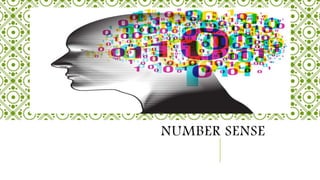
Number sense
- 1. NUMBER SENSE
- 2. WHAT IS NUMBER SENSE? “Number Sense" is a relatively new one in mathematics education. It is difficult to define precisely, but broadly speaking, it refers to "a well organized conceptual framework of number information that enables a person to understand numbers and number relationships and to solve mathematical problems that are not bound by traditional algorithms" (Bobis, 1996). The National Council of Teachers (USA, 1989) identified five components that characterize number sense: number meaning, number relationships, number magnitude, operations involving numbers and referents for numbers and quantities. These skills are considered important because they contribute to general intuitions about numbers and lay the foundation for more advanced skills.
- 3. Number sense is the ability to understand the quantity of a set and the name associated with that quantity. Number is an abstract concept, and young children tend to think in concrete terms. Thanks to recent research, we now know that children are sensitive to quantity and can make good quantity comparisons (more than, less than). The transition from this innate, informal number knowledge to a conventional understanding of number sense is a major cognitive development that takes place gradually.
- 4. GOOD NUMBER SENSE WITH SKILLS OBSERVED IN STUDENTS PROFICIENT IN THE FOLLOWING MATHEMATICAL ACTIVITIES: Mental calculation Computational estimation Judging the relative magnitude of numbers Recognizing part-whole relationships and place value concepts Problem solving
- 5. HOW WILL YOU USE OR HOW WILL YOU PERFORM NUMBERS ASIDE FROM COUNTING IT?
- 6. BIG IDEA: NUMBERS ARE USED IN MANY WAYS, SOME MORE MATHEMATICAL THAN OTHERS
- 7. FOCUS FOR FAMILIAR CARD GAMES Simple card games help young children develop their knowledge of early math topics like cardinality, number composition, and number comparison. When playing card games, using quantity cards with photographs instead of numerals enhances children's attention to numericity and adds excitement to favorite games like Go Fish or Memory.
- 8. *Quantity cards have pictures of small sets of dots, finger patterns, and 5- and 10- frames showing numbers from 1 to 10. Quantity cards require children to look at a picture and say how many they “see.” This attention to numerisity builds children ability to subitize. That is, children will instantly see a small quantity and label it with a number word. Most preschoolers will recognize three fingers without counting, “one, two, three.” Matching quantities such as dots and fingers develops ideas about equivalence. Though these two cards look quite different, they are the same in one important way—their numerosity. Experience recognizing how amounts that look different can actually be equivalent numbers helps children abstract the “three-ness” of three when playing card games. *Most importantly, quantity cards helps children build number relationships. Numeral cards present each number separately as a monolithic entity. Quantity cards depict numbers in relationship to other numbers. For example, the picture of 4 fingers also shows the thumb tucked away, allowing for children to think and talk about how
- 11. EX. Numbers don't just show up in math assignments, but they also appear in everyday writing. Like many facets of the English language, there are rules for writing numbers. Certain numbers are spelled out with letters and others are only written as numerals.
- 12. BIG IDEA: QUANTITY IS AN ATTRIBUTE OF A SET OF OBJECTS, AND WE USE NUMBERS TO NAME SPECIFIC QUANTITIES
- 13. Number sense growth requires an understanding of numerosity. When children acquire a better understanding of this Big Idea, they understand that when number words are used to name "how many," they are describing quantity, just as "red" and "hot" are describing color and temperature, respectively.
- 14. MANY WAYS TO SEE HOW MANY WITH NUMBER SENSE ACTIVITIES *How many times have you heard young children (or their parents) proudly exclaim how high they can count? Children love to master the sequence of counting words—reciting the number names in the same order every time—just as they love to sing their ABCs. Regardless of how high a preschooler can rote count, a child’s sense of what those numbers actually mean develops gradually. We call this understanding number sense, and it requires relating numbers to real quantities. Most three- year olds have a solid number sense for the quantities of 1, 2, and 3. That is, they can think about small numbers and their relationships such as 2 cookies is 1 for me and 1 for you or 3 toy cars and 2 tracks to race means 1 car will have to wait. By the time children leave preschool, most have developed number sense through 5, and many up through 10 and beyond. Two videos featuring the same preschooler vividly demonstrate how children can visualize small quantities in a
- 17. BIG IDEA: THE QUANTITY OF A SMALL COLLECTION CAN BE INTUITIVELY PERCEIVED WITHOUT COUNTING
- 18. Children are born with an ability to recognize sets of 1, 2, and 3 items, and with support, they can quickly name “how many” for collections of 4, 5, and sometimes more objects without counting one by one. This kind of visual number sense empowers children and fosters a meaningful understanding of quantity.
- 19. THANK YOU..